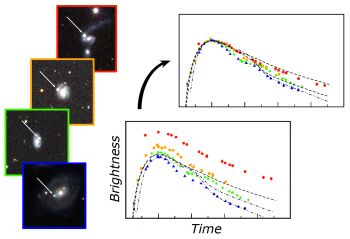 The Nearby Supernova Factory based at Berkeley Lab shows that Type Ia supernovae have a surprisingly large range of masses
The Nearby Supernova Factory based at Berkeley Lab shows that Type Ia supernovae have a surprisingly large range of masses
Until recently, scientists thought they knew why Type Ia supernovae are all so much alike. But their favorite scenario was wrong.
The assumption was that carbon-oxygen white dwarf stars, the progenitors of the supernovae, capture additional mass by stripping it from a companion star or by merging with another white dwarf; when they approach the Chandrasekhar limit (40 percent more massive than our sun) they experience thermonuclear runaway. Type Ia brightnesses were so similar, scientists thought, because the amounts of fuel and the explosion mechanisms were always the same.
Greg Aldering summarizes the most basic result of the new analysis: “The white dwarfs exploding as Type Ia supernovae have a range of masses, and the resulting light-curve width is directly proportional to the total mass involved in the explosion.”
Read the full press release at Berkley Lab

